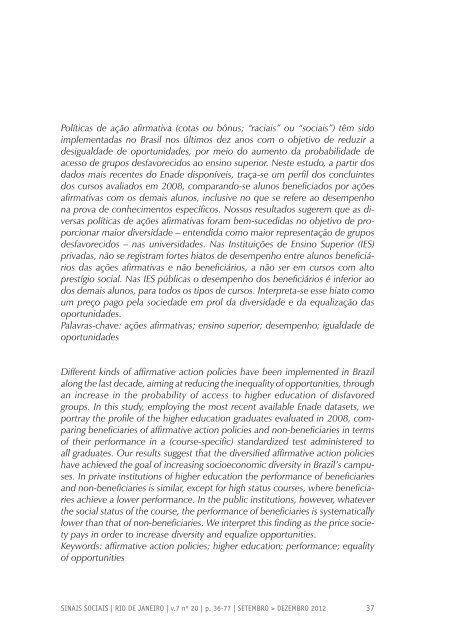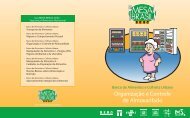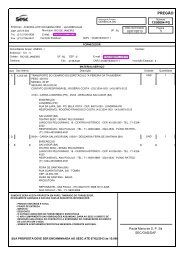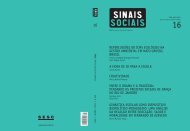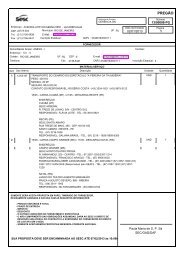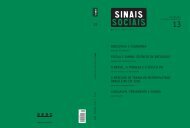Revista Sinais Sociais N20 pdf - Sesc
Revista Sinais Sociais N20 pdf - Sesc
Revista Sinais Sociais N20 pdf - Sesc
You also want an ePaper? Increase the reach of your titles
YUMPU automatically turns print PDFs into web optimized ePapers that Google loves.
Políticas de ação afirmativa (cotas ou bônus; “raciais” ou “sociais”) têm sido<br />
implementadas no Brasil nos últimos dez anos com o objetivo de reduzir a<br />
desigualdade de oportunidades, por meio do aumento da probabilidade de<br />
acesso de grupos desfavorecidos ao ensino superior. Neste estudo, a partir dos<br />
dados mais recentes do Enade disponíveis, traça-se um perfil dos concluintes<br />
dos cursos avaliados em 2008, comparando-se alunos beneficiados por ações<br />
afirmativas com os demais alunos, inclusive no que se refere ao desempenho<br />
na prova de conhecimentos específicos. Nossos resultados sugerem que as diversas<br />
políticas de ações afirmativas foram bem-sucedidas no objetivo de proporcionar<br />
maior diversidade – entendida como maior representação de grupos<br />
desfavorecidos – nas universidades. Nas Instituições de Ensino Superior (IES)<br />
privadas, não se registram fortes hiatos de desempenho entre alunos beneficiários<br />
das ações afirmativas e não beneficiários, a não ser em cursos com alto<br />
prestígio social. Nas IES públicas o desempenho dos beneficiários é inferior ao<br />
dos demais alunos, para todos os tipos de cursos. Interpreta-se esse hiato como<br />
um preço pago pela sociedade em prol da diversidade e da equalização das<br />
oportunidades.<br />
Palavras-chave: ações afirmativas; ensino superior; desempenho; igualdade de<br />
oportunidades<br />
Different kinds of affirmative action policies have been implemented in Brazil<br />
along the last decade, aiming at reducing the inequality of opportunities, through<br />
an increase in the probability of access to higher education of disfavored<br />
groups. In this study, employing the most recent available Enade datasets, we<br />
portray the profile of the higher education graduates evaluated in 2008, comparing<br />
beneficiaries of affirmative action policies and non-beneficiaries in terms<br />
of their performance in a (course-specific) standardized test administered to<br />
all graduates. Our results suggest that the diversified affirmative action policies<br />
have achieved the goal of increasing socioeconomic diversity in Brazil’s campuses.<br />
In private institutions of higher education the performance of beneficiaries<br />
and non-beneficiaries is similar, except for high status courses, where beneficiaries<br />
achieve a lower performance. In the public institutions, however, whatever<br />
the social status of the course, the performance of beneficiaries is systematically<br />
lower than that of non-beneficiaries. We interpret this finding as the price society<br />
pays in order to increase diversity and equalize opportunities.<br />
Keywords: affirmative action policies; higher education; performance; equality<br />
of opportunities<br />
SiNAiS SoCiAiS | Rio DE JANEiRo | v.7 nº 20 | p. 36-77 | SEtEmbRo > DEzEmbRo 2012<br />
37


